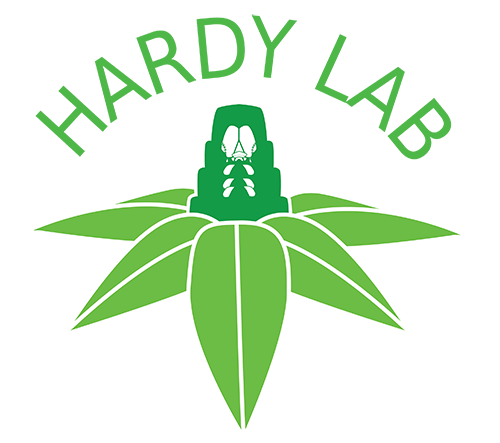Valid Names Results
Phalacrococcus howertoni Hodges & Hodgson, 2010 (Coccidae: Phalacrococcus)Nomenclatural History
- Phalacrococcus howertoni Hodges & Hodgson 2010: 11-19. Type data: U.S.A.: Florida, Monroe County, on Codiaeum variegatum; collected April 9, 2008, L. Howerton.. Holotype, female, Type depository: Gainesville: Florida State Collection of Arthropods, Division of Plant Industry, Florida, USA; accepted valid name Illustr.
Common Names
- Croton scale KondoBu2022
- Escama blanda del croto KondoBu2022
Ecological Associates
Hosts:
Families: 35 | Genera: 68
- Acanthaceae
- Ruellia blechum | HodgesHo2010 | (= Blechum brownei) (= Blechum linnaei)
- Anacardiaceae
- Mangifera indica | AmarasMa2011 EtiennMaKo2014 HodgesHo2010
- Schinus terebinthifolia | HodgesHo2010
- Spondias dulcis | HodgesHo2010 | (= Spondias cytherea)
- Spondias mombin | EtiennMaKo2014
- Spondias purpurea | HodgesHo2010
- Annonaceae
- Annona muricata | HodgesHo2010
- Annona squamosa | GermaiDeLa2016
- Araceae
- Alocasia | HodgesHo2010
- Colocasia esculenta | HodgesHo2010
- Asteraceae
- Bidens alba | HodgesHo2010
- Bidens pilosa | KondoBu2022
- Eclipta prostrata | HodgesHo2010
- Bignoniaceae
- Tabebuia heterophylla | HodgesHo2001
- Burseraceae
- Bursera simaruba | HodgesHo2010
- Calophyllaceae
- Calophyllum | HodgesHo2010
- Capparaceae
- Capparis cynophallophora | HodgesHo2010
- Quadrella siliquosa | HodgesHo2010
- Chrysobalanaceae
- Chrysobalanus icaco | HodgesHo2010
- Clusiaceae
- Clusia | HodgesHo2010
- Combretaceae
- Conocarpus erectus | AmarasMa2011
- Elaeocarpaceae
- Elaeocarpus | HodgesHo2010
- Euphorbiaceae
- Acalypha wilkesiana | EtiennMaKo2014 HodgesHo2010
- Codiaeum variegatum | EtiennMaKo2014 HodgesHo2010 | (= Croton variegatum)
- Euphorbia hirta | HodgesHo2010 | (= Chamaesyce hirta)
- Gymnanthes lucida | HodgesHo2010
- Jatropha integerrima | HodgesHo2010
- Heliconiaceae
- Heliconia | HodgesHo2010
- Lauraceae
- Licaria triandra | HodgesHo2010
- Nectandra membranacea | EtiennMaKo2014 | (= Ocotea membranacea)
- Persea americana | HodgesHo2010
- Loganiaceae
- Spigelia anthelmia | HodgesHo2001
- Malvaceae
- Sida | HodgesHo2010
- Melastomataceae
- Miconia furfuracea | EtiennMaKo2014
- Tetrazygia bicolor | HodgesHo2010
- Moraceae
- Artocarpus altilis | KondoBu2022
- Fatoua villosa | HodgesHo2010
- Ficus aurea | AmarasMa2011 HodgesHo2010
- Ficus citrifolia | EtiennMaKo2014
- Ficus drupacea | AmarasMa2011 HodgesHo2010 | (= Ficus mysorensis)
- Ficus microcarpa | HodgesHo2010
- Morus alba | HodgesHo2010
- Myrtaceae
- Calyptranthes pallens | HodgesHo2010
- Eugenia axillaris | HodgesHo2010
- Myrcianthes fragrans | HodgesHo2010
- Psidium guajava | AmarasMa2011 EtiennMaKo2014 HodgesHo2010
- Oleaceae
- Ligustrum japonicum | HodgesHo2010
- Oxalidaceae
- Averrhoa carambola | HodgesHo2010
- Phyllanthaceae
- Heterosavia bahamensis | HodgesHo2010 | (= Savia bahamensis)
- Phyllanthus urinaria | HodgesHo2010
- Piperaceae
- Piper dilatatum | EtiennMaKo2014
- Piper methysticum | HodgesHo2010
- Poaceae
- Digitaria | HodgesHo2010
- Polygonaceae
- Coccoloba diversifolia | HodgesHo2010
- Coccoloba uvifera | HodgesHo2010
- Primulaceae
- Ardisia escallonioides | Stocks2013a
- Myrsine cubana | HodgesHo2010 | (= Rapanea punctata)
- Myrsine guianensis | CastroMoWo2024
- Rubiaceae
- Hamelia patens | HodgesHo2010
- Ixora | KondoBu2022
- Morinda citrifolia | EtiennMaKo2014
- Psychotria ligustrifolia | HodgesHo2010
- Psychotria nervosa | HodgesHo2010
- Psychotria tenuifolia | HodgesHo2010 | (= Psychotria sulzneri)
- Randia aculeata | HodgesHo2010
- Spermacoce verticillata | HodgesHo2010
- Rutaceae
- Clausena lansium | HodgesHo2010
- Glycosmis pentaphylla | HodgesHo2010
- Zanthoxylum fagara | HodgesHo2010
- Zanthoxylum flavum | HodgesHo2010
- Sapindaceae
- Cupania glabra | HodgesHo2010
- Dimocarpus longan | HodgesHo2010
- Dodonaea viscosa | HodgesHo2010
- Filicium decipiens | HodgesHo2010
- Sapotaceae
- Chrysophyllum cainito | HodgesHo2010
- Manilkara jaimiqui | HodgesHo2010
- Sideroxylon celastrinum | HodgesHo2010
- Sideroxylon foetidissimum | HodgesHo2010
- Sideroxylon salicifolium | HodgesHo2010
- Simaroubaceae
- Simarouba glauca | Stocks2013a
- Verbenaceae
- Citharexylum spinosum | HodgesHo2010
- Phyla nodiflora | HodgesHo2010
- Zygophyllaceae
- Guaiacum sanctum | HodgesHo2010
Foes:
Families: 3 | Genera: 5
- Coccinellidae
- Azya orbigera | Stocks2013a
- Cryptolaemus montrouzieri | HodgesHo2010
- Thalassa montezumae | BarahoThAv2018 FranciKaMa2022
- Encyrtidae
- Metaphycus flavus | HodgesHo2010
- Pyralidae
- Laetilia coccidivora | HodgesHo2010 Stocks2013a
Geographic Distribution
Countries: 10
- Bahamas | KondoBu2022
- Barbados | EtiennMaKo2014
- British Virgin Islands | MalumpBaCo2019
- Cayman Islands | KondoBu2022
- French Guiana | KondoBu2022
- Guadeloupe | EtiennMaKo2014
- Guatemala | Willia2010
- Guiana | GermaiDeLa2016
- Puerto Rico & Vieques Island
- Puerto Rico | KondoBu2022
- United States
- Florida | Hodges2008a HodgesHo2010
Keys
- Hodgso2020: pp.221-223 ( Adult (M) ) [Coccidae species]
Remarks
- Systematics: The adult females of this species of soft scale share character-states with the Eulecaniinae (absence of dorsal tubercles, pocketlike sclerotisations and dorsal tubular ducts; spinose marginal setae, and multilocular disc-pores extending anteriorly onto thorax and head) but the multilocular disc-pores have 7 or fewer loculi, ventral tubular ducts are absent, the legs have an articulatory sclerosis and the claw digitules are broad. It also has character-states which it shares with the Paralecaniini (absence of dorsal tubular ducts; stigmatic clefts with sclerotizations; multilocular disc-pores with less than 10 loculi; ventral tubular ducts absent) but, again, it has characters that do not fit, namely eyespots on margin and multilocular disc-pores not restricted to posterior abdominal segments. It is close to Coccini but the absence of dorsal setae and the presence of strongly spinose marginal setae etc. makes it different from all known genera included in this group as defined by Hodgson (1994). (Hodges & Hodgson, 2010) The adult female of P. howertoni may be confused with Philephedra tuberculosa Nakahara & Gill which also occurs on ornamental croton in Guadeloupe and have similar coloration. However, the two species can be easily differentiated in the field since the mature adult female of P. tuberculosa has a white ovisac which is about twice as long as its body, with wax partially covering the dorsum, whereas the mature adult female of P. howertoni is mottled, green to yellowish in color, with dark specks and have no ovisac nor white wax partially covering the body. (Etienne, et al., 2014)
- Structure: Adult female oval to almost round, 2.5-5.3 mm long and 1.8-3.25 mm wide (venter slightly narrower, width 1.7-3.1 mm); anal cleft about 1/4th- 1/5th body length. (Hodges & Hodgson, 2010) First instar, second instar male and female, pupa and adult males described in detain in Hodges and Hodgson, 2010.
- Biology: The scale insect practiced ovoviviparity. Eggs that came out from vulva hatched to first instars immediately. Newly hatched nymphs had a tendency stay underneath the female body for somewhat less than approximately 24 hours then disperse throughout the leaf area for feeding. Females went through 3 immature stages (first, second, and third-instar) prior to becoming adults, while males had 4 immature stages (first, second, third (‘pre-pupa’), and fourth instar (’pupa’)). The female has a high fecundity with close to 400 live nymphs per female. The lifespan of adult males was very short (less than 1 d) at 27 ± 1°C compared to that of adult females (60.3-61.5 d). (Amarasekare & Mannion, 2011) Under the ecological conditions in Florida, P. howertoni has multiple overlapping generations a year, averaging about one a month. It overwinters as the adult female and each female can lay about 400 eggs. (Hodges & Hodgson, 2010)
- Economic Importance: Like most soft scales, P. howertoni eliminates large quantities of honeydew and this inhibits photosynthesis and encourages sooty mold. (Hodges & Hodgson, 2010) Its polyphagus nature and high reproductive ability therefore makes P. howertoni a potentially serious pest of tropical and subtropical ornamental and fruit plants and ecologically important mangrove plants such as buttonwood. (Amarasekare & Mannion, 2011)
- General Remarks: Description and illustration of adult female and male, and nymphs of female and male by Hodges & Hodgson (2010).
Illustrations
Citations
- AmarasMa2011: distribution, host, life history, 588-593
- BarahoThAv2018: biological control, entomopathogenic fungi, natural enemies,
- CamachCh2015: life history, 4
- CastroMoWo2024: host, 1
- EtiennMaKo2014: description, distribution, host, illustration, life history, 115-118
- FranciKaMa2022: biological control, natural enemies,
- GermaiDeLa2016: host, list of species, 2
- Hodges2008a: description, distribution, host,
- HodgesHo2010: description, distribution, host, illustration, taxonomy, 8-23
- Hodgso2020: key, 222
- KondoWa2022a: distribution, host, list, 11
- OuvrarKoGu2013: distribution, 3
- SkelleBuAl2025: dispersal, distribution, economic importance, history, host, record, 40
- Stocks2013a: distribution, host, natural enemies, 243
- Willia2010: distribution, host, 144-152


